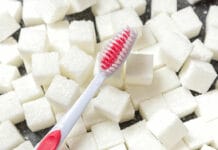Article sponsored by OraCoat.
Unless a person suffers from xerostomia (dry mouth), most people don’t give a second thought to saliva. That is until they are seated in the dental chair and find themselves drowning in it or are suddenly unable to swallow. All joking aside, saliva plays a crucial role in oral health. It aides in teeth remineralization, clears food from the mouth, helps maintain a neutral oral pH, and is even the beginning of the digestion process, to name a few. This often ignored bodily fluid, except by dental professionals, deserves some credit!
Here’s a look at saliva components and functions, oral pH, and stimulation of saliva with xylitol.
Saliva Components
Saliva is mostly composed of water, about 99%. The other 1% or so contains electrolytes (potassium, sodium, magnesium, calcium, chloride, bicarbonate, phosphate, and iodine), antibacterial compounds (i.e., lysozyme), mucus, and the enzyme amylase, which breaks down starches and are the beginning of the digestive process.
The basic secretary units of salivary glands are clusters of cells called acini. The components of saliva flow out of the acinus into collection ducts, where the composition of the secretion is changed. Most of the sodium is actively reabsorbed, and potassium is secreted, along with a large amount of bicarbonate ion. The small collecting ducts within saliva glands eventually form a single large duct that empties into the oral cavity.1
Important Functions of Saliva
As dental professionals, we see how xerostomia affects the oral cavity in our patients. It’s not only uncomfortable and makes speaking difficult, but can lead to a higher risk of decay, especially root caries. A decrease of saliva means a decrease in the remineralization components (calcium and phosphate) in saliva, along with a decrease of all the other components of saliva, including those that help keep a neutral oral pH (bicarbonate). Bacteria thrive in acidic environments, making a decrease of saliva a risk for periodontal disease and fungal infections.
Though not an exhaustive list, other important functions of saliva include:
- Lubricating and binding masticated food into a slippery bolus, which allows it to pass through the esophagus without causing damage to mucosa.1
- Saliva solubilizes food, which allows us to actually taste food.1
- Helping clear the mouth of food debris, which aids in removing fermentable carbohydrates (sugars) and acid.1
- Initiating of starch digestion by the enzyme amylase, which begins to digest dietary starch into maltose.1
- Acting as a primary line of defense. Proteins in saliva act as an antibacterial, antifungal, antivirus and/or antiparasitic substances. A few examples are:
-
- Lysozyme is a glycoside hydrolase which lyses gram-positive cell walls. It also has a permeability property which is active against both gram-positive and gram-negative bacteria. Lysozyme has antiviral properties and may induce lysis of tumor cells. Lysozyme binds to bacterial lipopolysaccharide, a bacterial surface structure and bacterial toxin, frequently responsible for tissue destructive inflammatory reactions.2 Lysozyme has antiviral properties and may induce lysis of tumor cells.2
- Histatins are antifungal, antiviral, and a broad spectrum antibacterial. They rupture cell walls by creating channels and entering the cell in both bacteria and fungi, especially Candida albicans. Histatins inhibit adhesion of cariogenic bacteria (i.e., S. mutans) and are highly important in would closure.2
- Lactoferrin is active against bacteria, fungi, parasites, and viruses due to its strong binding ability. It binds to iron ions needed for microorganism cell growth. This binding ability also allows it to destruct membranes of microorganisms.2
- Defensins exhibit broad antibacterial activity and exert antifungal and antiviral properties. They carry a positive net charge which binds to negatively charged bacterial cell embranes allowing aggregation and integration into the lipid bilayer. This integration results in the formation of ion channels, transmembrane pores, membrane leakages, and cell rupture, which leads to the destruction of bacteria.2
-
Oral pH
A quick review of pH: The pH scale goes from 1-14, with one being most acidic and 14 most alkaline; a neutral pH lies at 7. Generally, the mouth’s pH ranges between 6.2-7. Demineralization occurs when the mouth remains below the critical pH for 20-50 minutes. The critical pH for demineralization of enamel is about 5.5 and a pH of 6 for cementum.
When a person consumes acidic beverages and foods or fermentable carbohydrates, the pH of the mouth drops. As demonstrated by the Stephan Curve, it can take anywhere from 15-60 minutes for the mouth to recover to a neutral pH. The wide range of recovery time from an acid challenge is due to many factors; some include the composition and thickness of biofilm, buffering ability and amount of saliva, and whether fermentable carbohydrates were cleared or remain in the mouth.
For oral hygiene education and instructions to hit home with our patients, it’s always helpful to give the “why” behind our recommendations. For instance, educate patients on the length of recovery time after an acid attack, so they understand why sipping on soda or frequent snacking has negative effects and how saliva plays an integral role. If patients are going to drink a soda or eat chips (fermentable carbohydrates), it’s best to do so in one sitting, not over an extended length of time. Be sure to educate about the need to wait to brush for at least 30 minutes after eating or drinking. In the case of morning sickness, pregnant patients should be educated to not brush immediately after throwing up, as well.
Saliva Stimulation and Xylitol
Saliva stimulation is extremely important for our patients who suffer from xerostomia. While sipping on water may work for some in combating dry mouth, it doesn’t cut it for all, and a xerostomia relief product may be needed. Often, to stimulate saliva, patients will suck on candy or sip on sweetened beverages, which can wreak havoc on oral health. This is where xylitol may be helpful.
Xylitol is a natural sugar alcohol that occurs in the bark of birch trees, and other hardwood species that contain xylan.4 Xylitol is also found in corn husks, corn, lettuce, and strawberries, and at relatively high levels in plums, raspberries, and cauliflower.3
Xylitol is a 5-carbon alcohol sugar which cannot be easily metabolized by cariogenic bacteria, unlike 6-carbon sugars such as monosaccharides/simple sugars (i.e., glucose, fructose, galactose) and sorbitol or disaccharides/double sugars (i.e., sucrose/table sugar, lactose, maltose).3 Xylitol reduces levels of S. mutans in biofilm and saliva by disrupting their energy production process which leads to cell death.4 Bacteria are essentially starved, which reduces bacterial counts, and in turn, creates less acidic waste which reduces caries risk and helps maintain oral pH.4 Xylitol also reduces S. mutans’ ability to adhere to tooth surfaces.4 With long-term exposure to xylitol, biofilm is reduced because the type of cariogenic bacteria which dominates is shifted.3
Recommending Xerostomia Products
There are a plethora of xerostomia relief products which can make it difficult to choose which to recommend. A few points we might want to ask ourselves before recommending a product are:
- Does the product do more harm than good?
- Does the product provide any added benefits?
- Is the product efficacious?
- Is the product easily available for our patients to purchase?
The first concern about xerostomia products I tend to have is if they are acidic. The whole goal of relieving xerostomia is not only patient comfort but neutralizing oral pH. If we recommend products that are acidic, while the patient may find relief, we are putting them back at square one by increasing their risk of decay and encouraging an environment where virulent bacteria thrive.
Focusing on xylitol products specifically, does the product have any added benefits besides containing a good amount of xylitol alone? Are any humectants added to hold in moisture and lubricate tissues besides stimulating saliva alone?
Of course, not all products work for every patient. However, is there a supporting level of efficacy of a product? Is there research supporting a product and its ingredients? While anecdotal proof of efficacy is helpful, research is king.
If a product is not easily obtainable for a patient, your recommendation will most likely go in one ear and out the other. It’s easy for a patient to be able to purchase recommended products in your office. However, if that’s not a possibility, the next best thing is products easily found at grocery stores. Often, if a patient has to go to a certain website, they might not purchase the recommended product at all.
OraCoat XyliMelts® Discs
A unique xylitol product that fits the bill for all of the points above is OraCoat XyliMelts discs. OraCoat XyliMelts are fully dissolving, oral-adhering discs that stick to teeth or gingiva and slowly release xylitol and an oral moisturizer, called cellulose gum. Because XyliMelts discs are adhesive, they can be used at night while sleeping when saliva flow significantly decreases to provide comfort and reduce sleep disruption. A great thing about XyliMelts is that they aren’t acidic, they have a pH of 8 to help neutralize acids in the mouth.
XyliMelts go beyond lozenges because of their unique adhesive system. Slow release from adhering discs provides efficient delivery of xylitol, allowing it to linger in the mouth.
During the daytime, they can last for several hours and longer at night while sleeping. The adhesive completely dissolves and leaves no residue. This adhesive system is also why XyliMelts can be used at night; patients are very unlikely to knock it off accidentally after letting it fully adhere.
XyliMelts can be used with CPAP machines, oral appliances, dentures and can be used while eating and drinking.
How XyliMelts Work
As mentioned before, XyliMelts contain xylitol and an oral moisturizer to coat, soothe, and moisturize. 550 mg of xylitol per disc helps to suppress bacteria that flourish in a dry mouth, reduce plaque, and reduce the risk of decay. The mild mint flavor and xylitol help stimulate saliva and the oral moisturizer coats the mouth to retain moisture.
How to Apply XyliMelts
Each disc has a tan side and a white side. The tan side is the adhesive side, and the white side contains the xylitol and oral lubricant. Place the tan adhesive side against your gingiva, upper or lower in a comfortable spot. It is important not to move the disc for 10 seconds, so it has time to adhere to the gingiva. The adhesion will grow stronger over time.
XyliMelts are widely available and can be found over the counter at CVS, Rite Aid, and other stores. They cost around $10 for 40 discs, which is about 25 cents per disc. Being available over the counter makes them an easy choice for patients.
In Closing
From its antibacterial and remineralization properties to its buffering capacity, saliva plays a significant role in oral health. Using XyliMelts oral adhering discs is an easy way for patients to stimulate saliva throughout the day, after meals, and even during sleep, to receive all of saliva’s benefits. After all, saliva is a mouth’s best friend!
Get FREE samples of XyliMelts here!
To learn more XyliMelts, visit www.oracoat.com now!
References
- Tiwari, M. (2011). Science behind human saliva. J Nat Sci Biol Med. Jan-Jun; 2(1), 53-58. Retrieved from https://www.ncbi.nlm.nih.gov/pmc/articles/PMC3312700/
- Fabian, T.K., Hermann, P., Beck, A., Fejerdy, P., Gabian, G. (2012). Salivary Defense Proteins: Their network and role in innate and acquired oral immunity. Int J Mol Sci. 2012 Apr 2; 13(4): 4295-4320. Retrieved from https://www.ncbi.nlm.nih.gov/pmc/articles/PMC3344215/
- Pierce, K. All About Xylitol, the New Sugar: Sweetness with Benefits. (2018). Today’s RDH. Retrieved from https://www.todaysrdh.com/all-about-xylitol-the-new-sugar-sweetness-with-benefits/
- Hatfield, S. Does Xylitol Outshine Fluoride in the Fight against Tooth Decay? (2019). Today’s RDH. Retrieved from https://www.todaysrdh.com/does-xylitol-outshine-fluoride-in-the-fight-against-tooth-decay/











